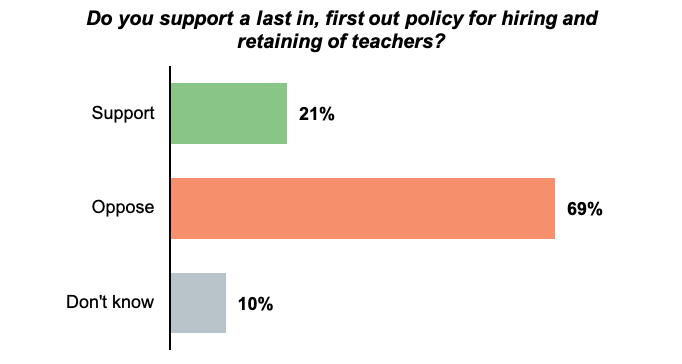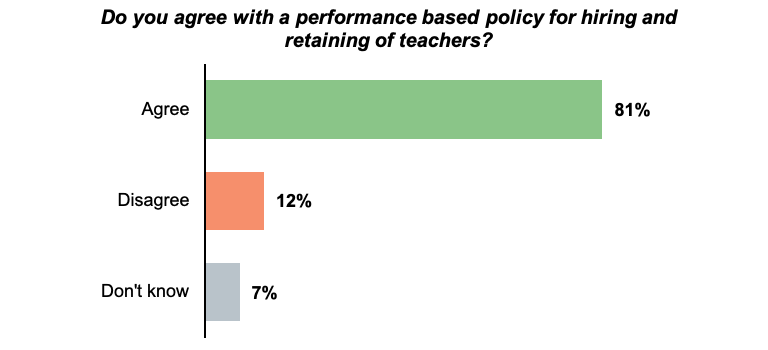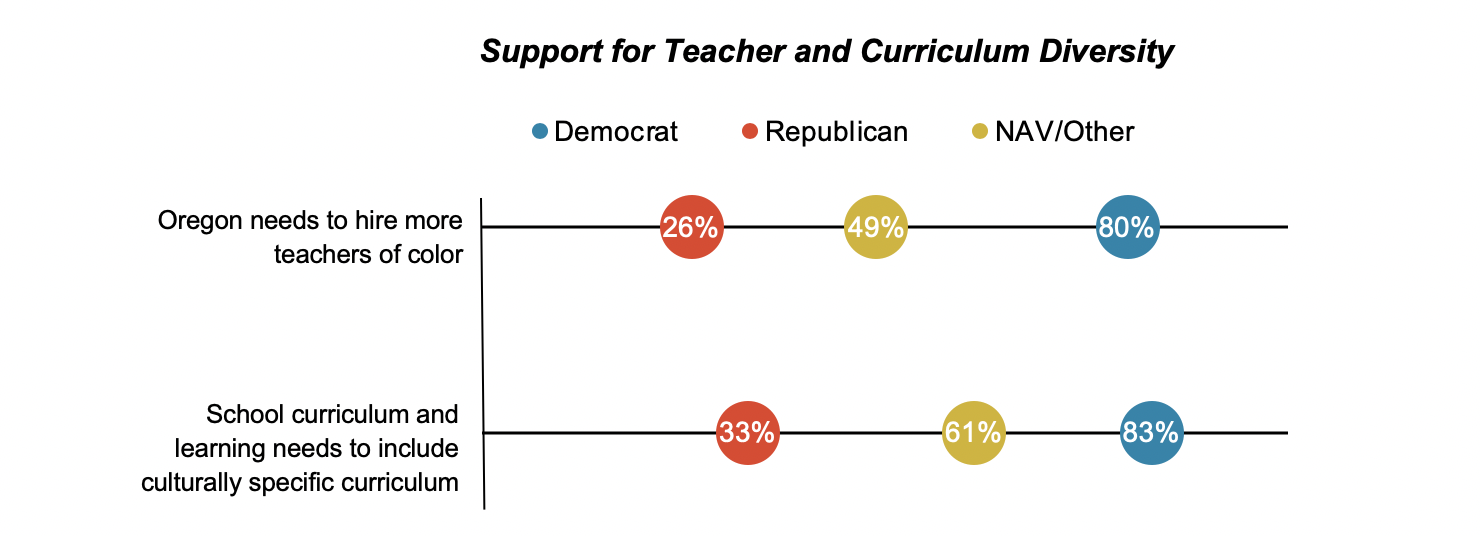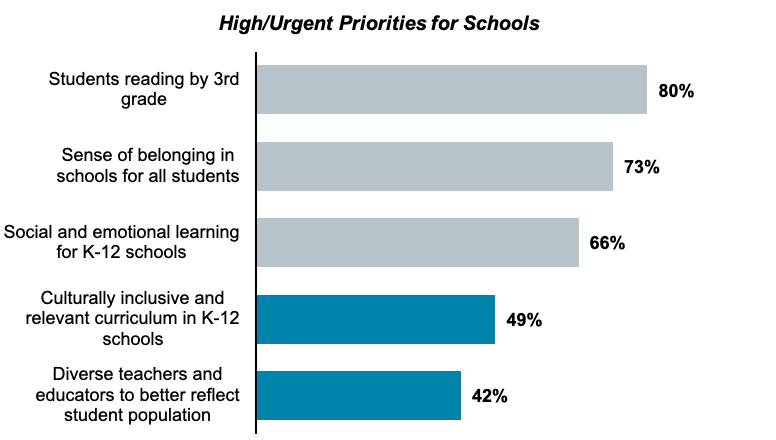DHM OVBC Panel July Survey Results
August 13, 2020
COVID-19 is creating complex challenges for schools in Oregon and across the country, from physical safety to the effectiveness of remote learning. Due to the economic impacts of COVID-19, many school districts may also be faced with financial problems. The decline of state and local revenue could force schools to layoff teachers and/or delay hiring.
In addition, the ongoing protests in response to the death of George Floyd have given new urgency to the issues of racial injustice. Schools are hearing these demands and considering ways to increase the diversity of teachers in the classroom and develop curriculum that represents and meets the needs of all Oregon students.
Oregonians reject public school hiring and retention policies that prioritize teachers’ length of service over performance.

We asked Oregonians about hiring and retention practices several ways in the survey, starting with their support or opposition to a practice commonly called “last hired, first fired.” This is a policy that, when making budget cuts, prioritizes retaining teachers who have the longest tenure, while the teachers that were most recently hired are the first to be let go. Just 20% of Oregonians support “last hired, first fired,” while 69% oppose it and 10% are unsure.
Unlike many policy issues, there are not significant differences in opinions between Democrats and Republicans. 69% of Democrats and 67% of Republicans oppose “last hired, first fired,” as do 75% of NAV/Other voters.
While this practice is opposed by every demographic group, there are modest differences in support levels by educational attainment. 27% of Oregonians with a high school degree or less support “last hired, first fired” compared to 20% of those with 2-year degree/some college and 13% of those with a 4-year degree. As we’ll see, this difference in education appears in other attitudes about teaching and curriculum.
Oregonians agree teachers should be retained based on their performance in student academic growth rather than how many years they have been teaching.

The flip side of “last hired, first fired” is a policy that prioritizes retaining teachers based on performance when budget cuts require reducing staff. 81% of Oregonians agree with this approach, while just 12% disagree. Again, there is little difference by party with 83% of Democrats, 79% of Republicans and 85% of NAV/Others in agreement. Though it is only a modest difference, Oregonians with more education are more agreeable than those with less education (84-85% of 2-year/some college and 4-year degree vs. 76% of high school or less).
Opinions about these hiring and retention practices may not be fixed. Oregonians are open to the idea that long-term teachers should be protected from being replaced by lower wage teachers.
Some say that “last hired, first fired” protects teachers who have given years of service to a school. Without this protection, school districts would have the incentive to replace higher wage, longer tenured teachers with lower wage, less experienced teachers.
With this in mind, we asked Oregonians if they agreed or disagreed with the statement: Teachers with seniority need to be protected, otherwise, they will be forced out of their jobs since newer and less experienced teachers are paid less. A majority, 51%, of Oregonians agreed with this statement compared to 37% who disagreed and 12% who were unsure.
Differences across the parties are somewhat greater on this question, with more Democrats (56%) and NAV/Others (52%) agreeing to the statement then Republicans (40%).
The differences by education level persist and there are also differences by income. Lower income Oregonians are more in agreement with this statement than those with higher incomes. Specifically, 59% of Oregonians with a high school degree or less agree to this statement compared to 45-46% of those with more education. Similarly, 57% of Oregonians with incomes below $25,000 agree versus 43-47% of those with incomes above $50,000.
Oregonians are split about the need for more teachers of color, with sharp differences by political party and other demographic groups.

Overall, 55% of Oregonians agree that schools in the state need to hire more teachers of color to better reflect the increasing number of students of color in the classroom, while 29% disagree and 16% are unsure.
Unlike “last hired, first fired” policies, when it comes to hiring for racial diversity there are large partisan differences with Democrats on one side, Republicans on the other and NAV/Other falling in between. Specifically, 80% of Democrats agreed with this statement compared to 26% of Republicans and 49% of NAV/Other.
Notably, these differences by party, education and geography are greater than the differences by race. 60% of Oregonians from communities of color and 54% of white residents agree with this statement.
Most Oregonians agree that school curriculum needs to include culturally specific context and experiences.
61% of Oregonians agree with the statement that school curriculum and learning needs to include culturally specific content and experiences, 25% disagree and 14% are unsure. Like teacher diversity, support is highest among Democrats (83%), college graduates (72%), and residents in the Portland metro area (73%). Also, like teacher diversity, there is little difference between communities of color (64%) and white residents (61%).
Despite overall support for teacher and curriculum diversity, most Oregonians do not consider these as high priorities for schools.
[1] Some Oregon counties outside of the Portland metro area and Willamette Valley have the highest percentages of non-white populations, particularly Jefferson, Morrow, Malheur, Hood River and Umatilla counties.

Just 49% of Oregonians believe think that culturally inclusive and relevant curriculum should be a priority population. Even fewer (42%).think that it should be a priority to have diverse teachers who reflect the student population. Oregonians rate these as lower priorities than other education needs, including creating a sense of belonging for all students (73%) and supporting students’ social emotional learning.
These issues-sense of belonging and social emotional needs-are certainly connected to the teachers in the classroom and the materials students are taught. There are opportunities to increase support for hiring and curriculum diversity by connecting these policies directly to students’ well-being.
The research was completed as a community service by DHM Research in partnership with the Oregon Values and Beliefs Center. Both organizations are independent and non-partisan. DHM Research is a Certified B Corporation and OVBC is an Oregon charitable nonprofit corporation.
